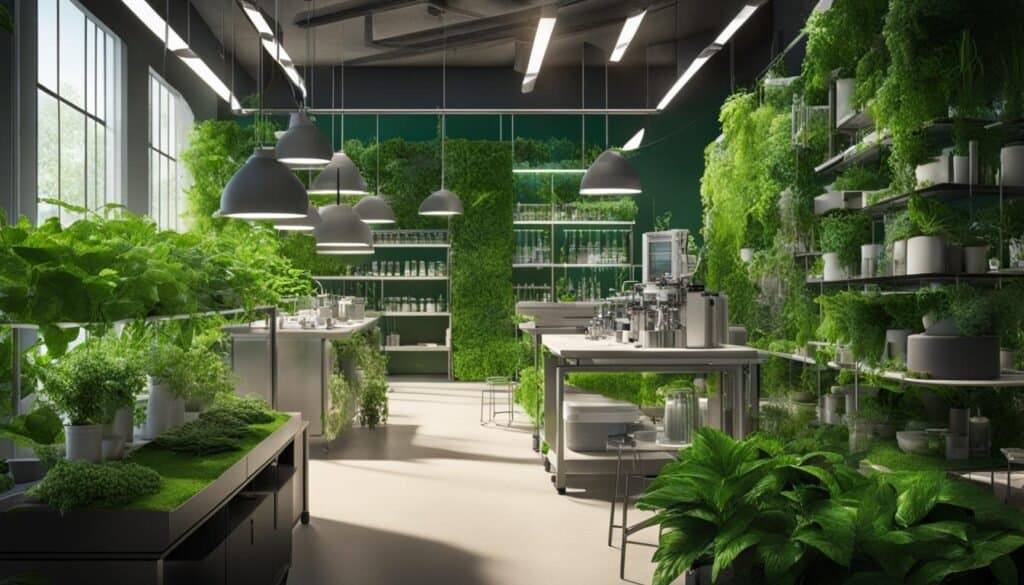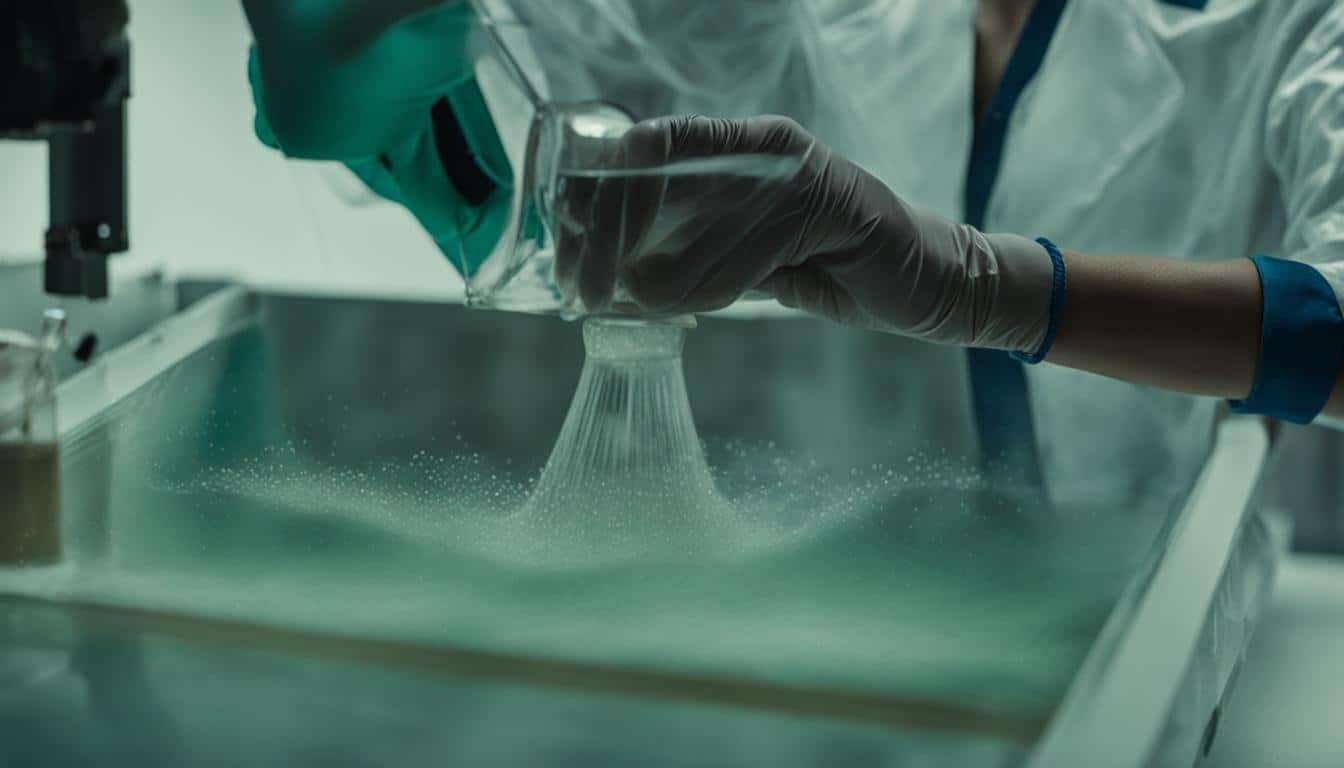Green chemistry in product development plays a large role, focusing on designing chemical products and processes that reduce or eliminate hazardous substances throughout their lifecycle. This approach aligns with the Pollution Prevention Act of 1990 and embraces green chemistry’s 12 principles, striving for sustainable chemistry and a more environmentally friendly approach.
To further support these endeavors and goals, the US Environmental Protection Agency (EPA) actively participates in establishing guidelines, providing green chemistry education, and partnering with organizations such as the American Chemical Society to stimulate the development of greener practices.
As our journey into sustainable product development unfolds, let’s delve into 11 examples of green chemistry in various industries and appreciate the EPA’s contributions in ensuring a safer, healthier future for all.
Key Takeaways
- Green chemistry focuses on reducing harmful substances throughout a product’s lifecycle.
- The EPA actively collaborates with organizations such as the American Chemical Society to promote green chemistry education and innovation.
- Biodegradable plastics, sustainable industrial processes, and eco-friendly pesticides are just a few examples of green chemistry in action.
- Life cycle analysis plays a crucial role in selecting sustainable materials for greener product development.
- Incorporating green chemistry principles contributes to a more sustainable and environmentally responsible society.
Incorporating Biodegradable Plastics into Consumer Products
Biodegradable plastics offer a viable alternative to traditional polymers, which are often derived from depletable fossil fuels. By transitioning to materials that are derived from renewable feedstocks and can degrade into innocuous substances post-use, product developers are reducing environmental impact and improving sustainability. Green chemistry principles such as using renewable feedstocks and designing products to degrade after use are particularly relevant in the development of these eco-friendly materials.
Transitioning Traditional Polymers to Green Alternatives
Replacing traditional plastics with biodegradable alternatives has gained momentum in recent years. As research progresses, innovative polymers derived from renewable materials like starch, cellulose, and even food waste have emerged. These green alternatives not only bridge the gap between functionality and sustainability but also pave the way for a cleaner environment. Moreover, these advancements in polymer innovation exemplify the integration of sustainable product development and green chemistry principles.
Prevention: The American Chemical Society emphasizes the importance of preventing waste in green chemistry, advocating for waste reduction rather than treating or cleaning up after its creation.
The Role of Life Cycle Analysis in Selecting Sustainable Materials
Life cycle analysis (LCA) plays a crucial role in selecting sustainable materials for consumer products. By evaluating the environmental impact of materials from production to disposal, manufacturers can make informed decisions that minimize ecological footprint. LCA encompasses evaluating energy and resource use, emissions, and the potential for pollution, ensuring that products align with green chemistry’s goals of waste prevention and pollution reduction.
| Aspect | Biodegradable Plastics | Traditional Plastics |
|---|---|---|
| Source | Renewable materials (e.g., starch, cellulose) | Depletable fossil fuels |
| Environmental Impact | Lower; degrades into innocuous substances | Higher; persists in the environment |
| Green Chemistry Principles | Using renewable feedstocks, designing products to degrade after use | Not applicable |
The implementation of environmental impact assessment and green product design principles enables manufacturers to develop better, eco-friendly products while empowering consumers to make informed decisions. Incorporating biodegradable plastics in consumer products not only reduces environmental impact but also catalyzes the transformation toward environmentally conscious societies.
Renewable Feedstocks in Industrial Processes
Renewable feedstocks play a pivotal role in promoting sustainable industrial processes by providing eco-friendly alternatives to traditional sources such as petroleum, natural gas, or coal. Aligning with green chemistry principles, these feedstocks encompass agricultural products, bio-based raw materials, and waste from other processes, effectively decreasing the environmental impact of various industries.
As a result, the reliance on fossil fuels is significantly reduced, leading to a decrease in global warming, ozone depletion, and smog formation. Moreover, the use of renewable feedstocks contributes to the development of sustainable manufacturing processes and drives the push towards a greener future.
Renewable feedstocks are central to green chemistry, offering sustainable alternatives to depletable traditional sources and fostering environmentally responsible industrial practices.
One of the primary advantages of renewable feedstocks is their ability to serve as bio-based raw materials, enabling feedstock substitution in a variety of manufacturing processes. By replacing conventional resources with more sustainable alternatives, industries can minimize their environmental footprint and adhere to green chemistry principles. The following list provides a few examples of renewable feedstocks:
- Agricultural waste, such as corn cobs and sugarcane bagasse
- Plant-based oils, including soybean and palm oils
- Algae, a versatile and rapidly renewable resource
- Wood and cellulose fibers, derived from sustainably managed forests
- Biogas, produced through anaerobic digestion of organic waste products
The choice of feedstock depends on various factors, such as availability, cost, environmental impact, and the end-use of the product. As the demand for sustainable and eco-friendly products grows, the incorporation of renewable feedstocks in industrial processes is set to soar, paving the way for a cleaner and greener future.
| Industry | Traditional Feedstock | Renewable Feedstock |
|---|---|---|
| Plastics | Petroleum-based raw materials | Polylactic acid (PLA) derived from corn starch |
| Textiles | Fossil-based synthetic fibers | Lyocell fibers made from wood pulp |
| Chemicals | Crude oil and natural gas | Bioethanol from lignocellulosic biomass |
In conclusion, renewable feedstocks hold the key to transforming traditional industrial processes into sustainable and environmentally friendly practices. By embracing green chemistry principles and utilizing bio-based raw materials, industries can significantly reduce their environmental impact and contribute to a brighter future for our planet.
Utilizing Hydrogen Peroxide for Cleaner Bleaching Methods
As the textiles and paper industries continue to evolve, there is an increasing urgency to implement cleaner and more sustainable production methods. One significant shift involves the use of hydrogen peroxide in bleaching processes, which provides a greener alternative to traditional chlorine-based bleaches. By doing so, these industries are advancing cleaner production methods and promoting eco-friendly bleaching.
Advancements in Textiles and Paper Industries
Textiles and paper manufacturing both have a long history of using harsh chemicals in their production processes, often contributing to air and water pollution. With the adoption of hydrogen peroxide bleaching, these industries have substantially reduced their release of hazardous chemicals, improving environmental safety and air and water quality. This significant milestone in cleaner production aligns with green chemistry’s principles of designing safer chemicals and products, also benefiting industry workers’ health and well-being.
“The adoption of hydrogen peroxide bleaching in the textiles and paper industries has led to significant improvements in environmental safety and reduced hazardous chemical releases.”
Some of the essential benefits of hydrogen peroxide bleaching in these industries include:
- Decreased water and air pollution
- Reduced dependency on chlorine-based bleaches
- Improved workplace safety for employees
To illustrate the growing momentum of hydrogen peroxide usage, the following table provides compelling examples of its adoption in various production processes:
| Industry | Process | Role of Hydrogen Peroxide |
|---|---|---|
| Textiles | Bleaching of natural and synthetic fibers | Provides an eco-friendly solution for the refinement, coloration, and improvement of natural and synthetic fibers |
| Paper | Pulp bleaching | Enhances the whiteness and brightness of the pulp, while reducing the environmental impact associated with traditional bleaching processes |
| Laundry/Dry cleaning | Bleaching agent in detergent formulations | Offers a safer alternative to chlorine-based bleaches, with superior cleaning performance and minimal impact on fabrics |
With the implementation of hydrogen peroxide bleaching, both the textiles and paper industries are making substantial strides towards cleaner production methods. This transition towards more eco-friendly practices is essential to promoting a healthier environment, improved working conditions, and a more sustainable future for these industries.
Innovations with Chemical Catalysts to Enhance Reaction Efficiency

In the realm of sustainable chemistry, innovations in chemical catalysts are contributing significantly to enhanced reaction efficiency, leading to waste minimization and reduced energy consumption in various chemical processes. The use of these advanced catalysts allows for multiple reactions with minimum amounts of reagent, ensuring a more eco-friendly approach to manufacturing.
So, how do these innovations align with the principles of green chemistry? By employing catalysts, manufacturers can stay in line with the idea of maximizing atom economy. This ensures that the utmost efficiency is achieved in terms of the number of atoms used for every reaction, effectively reducing waste and the need for additional resources.
Designing Safer Chemicals: Chemical products should be designed to maintain their effectiveness while reducing toxicity, thus ensuring safety for human health and the environment.
Optimizing the use of chemical catalysts is a game-changing approach, as it not only improves reaction efficiency but also supports the development of more sustainable chemical processes.
- Catalyst Innovation: Recent advancements in catalyst development include the use of nanotechnology, tailored organometallic complexes, and enzyme mimetics, contributing to improved selectivity and increased turnover rates.
- Waste Minimization: Catalysts help minimize waste by ensuring that atoms are used maximally, which in turn supports the larger sustainable manufacturing principle of using fewer resources, hence creating less waste.
- Energy Efficiency: The use of catalysts reduces energy requirements in chemical processes, as reactions can be performed at lower temperatures or pressures, thereby contributing to greener operations and reduced greenhouse gas emissions.
Industry sectors that greatly benefit from catalyst innovations include pharmaceuticals, petrochemicals, food production, and fine chemicals. The ongoing research and development of advanced catalysts pave the way for continual growth and increasing viability of eco-friendly chemical processes.
The continuous improvement and development of chemical catalysts are proving to be vital in creating more sustainable chemical processes, aligning with the principles of green chemistry and promoting better environmental stewardship. Embracing catalyst innovation contributes to a brighter, cleaner, and more sustainable future.
Improving Protein Analysis Techniques in Food Science

Green chemistry has substantially contributed to the development of more efficient and environmentally friendly protein analysis techniques in the field of food science. One major area of improvement has been the reduction of toxic solvents in laboratory settings, leading to safer and more sustainable food ingredients analysis processes.
Reducing Toxic Solvent Use in Laboratory Settings
Historically, the use of toxic solvents in food analysis laboratories posed significant risks to the safety of scientists and the environment. Thanks to the principles of green chemistry, however, there has been a noteworthy decline in the use of hazardous chemicals in laboratory practices. As a consequence, laboratory spaces have become safer for scientists, while also minimizing the potential for pollution and its associated negative environmental impacts.
The adoption of green laboratory practices not only results in a safer working environment but also leads to the development of consumer products with reduced chemical risks. By minimizing the use of toxic solvents in food analysis, scientists are able to align with the guiding principles of green chemistry, which emphasize safety for workers and the design of processes that produce less chemical waste.
Green chemistry has led to improvements in protein analysis techniques in the realm of food science, notably through the reduction of toxic solvents in laboratory settings.
Within the realm of food science, a comprehensive understanding of protein analysis techniques is essential for ensuring the safety and quality of consumer products. Several notable advancements in green chemistry practices have contributed to this field, including:
- Green extraction techniques that utilize non-toxic solvents
- Eco-friendly chromatography methods for protein separation
- Development of biodegradable lab materials, such as plasticware
These advancements showcase the pivotal role of green chemistry in enhancing protein analysis techniques in food science, proving its indispensable value for ensuring safe and sustainable food ingredients analysis processes.
Sustainable Formulations in Personal Care Products

Sustainable formulations in personal care products are a key example of green chemistry in action, focusing on the use of less hazardous and more environmentally friendly ingredients. The move towards formulations that are free from harmful chemicals not only benefits consumers by providing safer products, but also decreases the environmental impact associated with traditional personal care products. This approach adheres to green chemistry principles, including the design of safer chemicals and the use of renewable feedstocks.
Major brands in the personal care industry have recognized the importance of sustainability and have committed to using eco-friendly ingredients in their products. Some examples of these ingredients, replacing their traditional counterparts, include:
| Traditional Ingredient | Eco-friendly Alternative |
|---|---|
| Parabens | Natural preservatives (e.g., grapeseed extract, rosemary extract) |
| Sulfates | Sulfate-free/less harsh surfactants (e.g., decyl glucoside, saponified oils) |
| Silicones | Natural oils and butters (e.g., shea butter, argan oil) |
| Synthetic fragrances | Essential oils and natural fragrances |
| Chemical sunscreens | Mineral-based sunscreens (e.g., zinc oxide, titanium dioxide) |
Furthermore, green product design in personal care products extends beyond the ingredients lists. Brands are also focusing on packaging, distribution, and end-of-life product disposal to ensure a comprehensive commitment to sustainability. For instance, many brands are now offering refillable packaging or using recycled materials for their products to reduce waste.
“The beauty of green chemistry is that it not only results in safer, more sustainable products, but also fosters innovation in product development and creates a positive impact on the environment and human health.” – Graham Hutchings, Professor of Sustainable Chemistry
In conclusion, the growing emphasis on sustainable formulations in personal care products showcases the significant practical application of green chemistry principles. As brands continue to innovate and invest in eco-friendly ingredients and practices, consumers can enjoy safer and more sustainable products while contributing to a healthier planet.
Developing Eco-friendly Pesticides for Agriculture

The development of eco-friendly pesticides in agriculture is a crucial application of green chemistry and an essential step towards sustainable agriculture practices. Traditional chemical pesticides often have unintended consequences, damaging ecosystems, and affecting non-target species. To combat these adverse effects, researchers are increasingly focusing on the development of eco-friendly pesticides, which provide targeted pest control while reducing by-catch and minimizing harmful effects on the environment.
Advances in Targeting Specific Pests and Reducing By-Catch
One of the most significant challenges in the design of eco-friendly pesticides is selectively targeting intended pests without harming other organisms such as beneficial insects, wildlife, and humans. With the help of green chemistry and precision agriculture, researchers can now develop pesticides that are highly specific and degrade rapidly once their intended use is complete. These advances contribute to a healthier ecosystem, protecting non-target species and promoting safer food supplies.
“By designing specific pesticide targets, we can reduce the number of chemicals introduced into the environment and minimize non-target by-catch, resulting in a more sustainable approach to pest control,” according to Dr. Janet Andersen, a leading researcher in the field of sustainable agriculture practices.
Some benefits of using eco-friendly pesticides include:
- Reduced chemical residue on crops, leading to safer food for consumers
- Fewer harmful effects on the environment, including reduced contamination of water sources and soil
- Minimized harm to beneficial insects and other non-target species
- Lower greenhouse gas emissions compared to conventional pesticide manufacturing processes
| Traditional Pesticides | Eco-friendly Pesticides |
|---|---|
| Non-selective, affecting a wide range of organisms | Highly targeted, minimizing harm to non-target species |
| Persistent chemical residues on crops and in the environment | Rapid degradation, reducing persistence in the environment |
| Higher risk of chemical runoff, contaminating water sources | Lower risk of runoff, protecting water sources |
| Increased harm to beneficial insects, disrupting ecosystems | Minimal impact on beneficial insects, promoting ecosystem stability |
In conclusion, developing eco-friendly pesticides is an essential component of sustainable agriculture practices. By adopting these innovative and environmentally responsible pest control methods, we can significantly reduce the negative impact of agricultural chemicals on the environment and human health. Through continued research and the widespread adoption of green chemistry principles, we can work together to foster a more sustainable future for our planet.
Green Chemistry in Building Materials – The Path to Healthier Habitations

The integration of green chemistry in building materials, particularly in the development of bio-based insulation, has set the stage for healthier and more sustainable living environments. By utilizing materials derived from renewable resources, the construction industry is making strides in reducing its environmental impact while creating energy-efficient housing that relies less on harmful chemicals. This approach exemplifies a commitment to the principles of green chemistry, aiming for a safer and more sustainable habitation experience.
Enhancing Insulation with Bio-based Foams
An excellent example of green chemistry in building materials is the use of bio-based insulation. These eco-friendly insulators mainly consist of bio-based foams derived from renewable resources like soy, corn, and other natural polymers. In contrast to traditional petroleum-based foams, bio-based insulations are more sustainable, have a lower carbon footprint, and offer improved indoor air quality.
“Bio-based insulation materials not only reduce our dependency on petrochemicals but also improve the overall energy efficiency of our homes by providing better thermal performance.”
Here are some of the most popular bio-based insulation materials currently available on the market:
- Cellulose insulation – Made from recycled newspapers, cardboard, and other paper materials.
- Sheep wool insulation – Sourced from sheep’s wool and treated with a biodegradable solution for moisture resistance.
- Wood fiber insulation – Manufactured from sustainably sourced wood fibers.
- Cork insulation – Derived from the bark of cork oak trees and has excellent insulative properties.
Not only do these materials promote eco-friendly construction practices, but they also pave the way for green home designs that prioritize energy efficiency, indoor environmental quality, and overall sustainability.
Bio-based insulation materials offer various advantages over conventional options, including lower embodied energy, better thermal performance, enhanced moisture management, and improved indoor air quality. Additionally, these materials are instrumental in promoting sustainable habitation by conserving energy, reducing greenhouse gas emissions, and minimizing waste.
| Insulation Material | Environmentally Friendly Attributes |
|---|---|
| Cellulose insulation | Non-toxic, made from recycled materials, biodegradable, excellent insulation properties |
| Sheep wool insulation | Renewable, sustainable, excellent insulation properties, naturally fire-resistant |
| Wood fiber insulation | Sustainably sourced, biodegradable, excellent insulation properties, requires less energy to produce |
| Cork insulation | Renewable, biodegradable, excellent insulation properties, low-energy production process |
By prioritizing green chemistry building materials, eco-friendly construction practices, and green home design, the construction industry can help pave the way to a healthier, more sustainable future for all.
Pharmaceuticals and the Shift toward Greener Synthesis Techniques
The pharmaceutical industry has experienced a shift toward greener pharmaceuticals and has made significant strides in incorporating sustainable synthesis techniques and green chemistry in drug development. This approach has led to more environmentally friendly medicine production and safer pharmaceutical processes, ultimately contributing to pollution prevention and human health protection.
Among the key advancements in sustainable drug development include the use of bio-based materials and catalysts that improve reaction efficiency, reducing waste and energy consumption. Moreover, pharmaceutical companies have implemented cleaner manufacturing processes that minimize environmental impact and toxic waste generation, prioritizing the overall safety and sustainability of medicine production.
The adoption of green chemistry principles in the pharmaceutical industry has revolutionized the approach to drug development, ensuring a more environmentally responsible and health-conscious future.
Below is a table that highlights some of the sustainable practices adopted in pharmaceutical development:
| Practice | Brief Description | Impact on Sustainability |
|---|---|---|
| Biocatalysis | Use of natural enzymes or microorganisms to catalyze chemical reactions | Reduction of hazardous byproducts and energy consumption |
| Flow Chemistry | Continuous chemical reactions in a flow reactor, as opposed to batch processing | Improved energy efficiency, waste reduction, and enhanced safety for chemists |
| Green Solvents | Use of environmentally benign solvents in drug synthesis processes | Reduced harm to the environment and improved safety for laboratory workers |
| Atom Economy | Maximizing the use of starting materials in a chemical reaction | Decreased waste generation and increased resource efficiency |
These sustainable practices have the potential to greatly impact the pharmaceutical industry and the environment as a whole. By working together to integrate and adopt these practices, the industry can move closer to creating a safer and greener future for all.
Paints and Coatings That Promote Air Quality and Durability
The paint and coatings sector has made significant strides in promoting air quality and durability by transitioning from solvent-based to water-based formulas. These innovations respond to the green chemistry principle of using safer solvents and reaction conditions by reducing harmful emissions and waste.
Foster Collaboration: Encouraging the exchange of green chemistry solutions among suppliers and product makers, and building partnerships to address key challenges, is a strategy highlighted by GreenBiz for advancing green chemistry.
Furthermore, water-based paints contribute to a circulatory approach by being easier to clean and less toxic, thus enhancing the environmental profile of the industry and improving the safety of its products for consumers.
Water-based paints offer a sustainable solution for paint industry innovation, promoting better air quality while providing durable coatings that meet consumers’ demands.
Let’s explore some benefits of choosing water-based paints over solvent-based alternatives:
- Improved air quality: Water-based paints emit fewer volatile organic compounds (VOCs), which can have detrimental effects on both indoor and outdoor air quality. Reducing VOCs helps maintain a healthier environment and minimizes respiratory health issues associated with poor air quality.
- Reduced environmental impact: By reducing the amount of toxic solvents used in paint formulations, water-based paints contribute to a cleaner environment, with fewer hazardous waste products being generated and disposed of.
- Improved safety: Water-based paints are less flammable than solvent-based paints, reducing fire hazards and improving workplace safety.
It is important to note that the paint industry’s shift towards water-based paints has not come at the expense of quality. Technological advancements have allowed for the development of durable coatings that perform just as well, if not better, than their solvent-based counterparts.
| Water-Based Paints | Solvent-Based Paints |
|---|---|
| Lower VOC content | Higher VOC content |
| Less flammable | More flammable |
| Environmentally friendly | Less environmentally friendly |
| Easier to clean up (water-soluble) | Harder to clean up (requires solvents) |
| Compatible with a wide range of substrates | Less versatile in terms of substrate compatibility |
In conclusion, the transition from solvent-based to water-based paints is an excellent example of how paint industry innovation aligns with green chemistry principles. By prioritizing eco-friendly solutions and focusing on air quality improvement and durable coatings, the industry is moving towards a more sustainable future.
Conclusion on Principles of Green Chemistry
In conclusion, sustainable product development using green chemistry is a powerful tool for creating lasting impact on environmental safety and fostering better green industry practices. Businesses and innovators who recognize the potential of green chemistry are reshaping and transforming industries, ensuring a safer future for both people and the planet. I’m excited to see what innovative breakthroughs are yet to come, and how the US EPA will continue to lead and support these advancements.
As a professional in the field, I can attest to the importance of incorporating green chemistry’s principles in our everyday practices, aiming for safer and more environmentally friendly products and processes. By doing so, we set the stage for a more sustainable society where the negative impacts of traditional industrial processes can be greatly reduced or even eliminated.
By working together, businesses, regulators, and scientists can ensure the future of green chemistry will continue to advance and have a positive impact in reducing the ecological footprint of industries, protecting human health, and achieving a more sustainable and eco-conscious world. As we look to the future, let’s hope that the power of green chemistry can foster a greener and healthier world for generations to come.
FAQ on Green Chemistry in Product Development
Q: What are the 12 principles of green chemistry?
A: The 12 principles of green chemistry are guidelines that encourage the design of chemical products and processes that reduce or eliminate the use and generation of hazardous substances.
Q: How does green chemistry relate to chemistry and engineering?
A: Green chemistry is the design of chemical products and processes that minimize the potential for chemical accidents and eliminate the use of and generate substances that are hazardous to human health and the environment, thus intersecting with chemistry and engineering.
Q: Why is green chemistry important in product formulation?
A: Green chemistry is crucial in product formulation as it focuses on the generation of hazardous substances, the avoidance of chemical derivatives, and the use of real-time monitoring and control whenever possible.
Q: What are the 12 examples of green chemistry in product development?
A: The 12 examples include the Estée Lauder Companies’ commitment to green chemistry, the reduction of toxicity in chemical processes, and the implementation of catalytic reactions to decrease the use of raw materials and energy.
Q: How does green chemistry aim to reduce pollution?
A: Green chemistry aims to reduce pollution by designing chemical products and processes that minimize the potential for chemical accidents, as well as by eliminating the use and generation of substances that are hazardous to human health and the environment.
Q: What is the role of the US EPA in green chemistry?
A: The US EPA supports green chemistry by promoting the development and implementation of green chemistry technologies, principles, and practices to foster sustainable innovation and reduce the environmental and health impacts of chemical products and processes.
Q: How does green chemistry benefit chemical processes?
A: Green chemistry benefits chemical processes by emphasizing the design of chemical products that have little or no toxicity, reducing the temperature and pressure requirements for chemical reactions, and aiming to avoid chemical derivatives.
Q: What can the green chemistry community do to promote sustainable development?
A: The green chemistry community can promote sustainable development by encouraging the use of green chemistry principles in chemical products and processes, as well as by advocating for the elimination of hazardous substances and the implementation of monitoring and control measures.
Q: How does green chemistry contribute to minimizing the potential for chemical accidents?
A: Green chemistry contributes to minimizing the potential for chemical accidents by designing chemical products and processes that have little or no toxicity, thereby reducing the risks associated with chemical handling and usage.
Q: What are the key considerations for green chemistry in the development of chemical products?
A: The key considerations for green chemistry in the development of chemical products include the minimization of the potential for chemical accidents, the reduction of toxicity, and the design of products that align with the 12 principles of green chemistry.





Leave a Reply